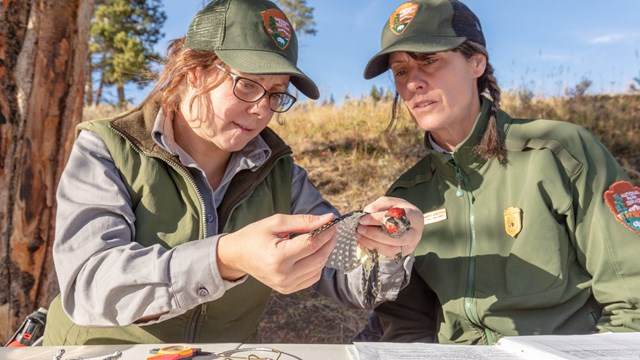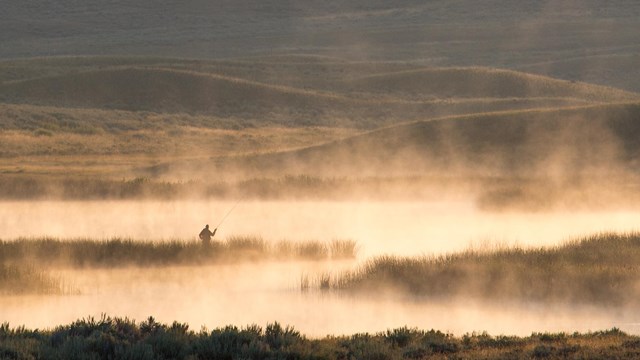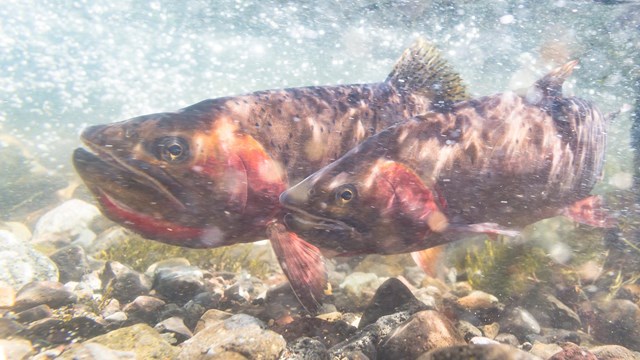
Aquatic Invasive Species in YellowstoneDuring the late 1880s when the Army administered Yellowstone, the US Fish Commission (a predecessor of today’s US Fish and Wildlife Service) stocked nonnative fish in some park waters. These stockings are the first known, deliberate introductions of nonnative fish to Yellowstone. 
New Zealand Mud SnailsThe New Zealand mud snail (Potamopyrgus antipodarum) is an invasive species that was first found in the western United States in the 1980s. Their habitat includes flowing water and some geothermal streams. The snails can form dense colonies on aquatic vegetation and streambed rocks. This crowds out invertebrates that are a primary food for immature trout and other native species.New Zealand mud snails consume large amounts of algae, which is a primary food for native aquatic invertebrates. Its impact on algae is likely to affect entire stream food webs. With its protective shell, the mud snail provides little if any nutrition to its predators. It may pass through a fish alive. Scarcely a quarter-inch long, mud snails may cling to boats, trailers, waders, and other fishing gear. This gear can inadvertently transfer the snails to another waterbody. Because the species can reproduce asexually, a single mud snail is all that is required to establish a new colony. PopulationFirst detected in the park in 1994, New Zealand mud snails are now in all major watersheds. Although they are abundant in several streams, they are absent or uncommon in others. This suggests that the mud snail's upstream density and distribution is limited by spring runoff. Spring runoff can cause colder temperatures, low productivity, and unstable streambeds. Impacts of Mud SnailsOnce mud snail colonies become established in a stream, removing them without disrupting native invertebrates is not possible. Mud snail research aims to determine the species’ impacts on the aquatic ecosystem. A study of the Gibbon and Madison rivers found that 25–50% of the macroinvertebrates were mud snails. The areas they occupied had fewer native mayflies, stoneflies, and caddisflies. These insects are important in the diet of native fish and several bird species. 
Whirling DiseaseWhirling disease is caused by a microscopic parasite from Europe (Myxobolus cerebralis) that can infect some trout and salmon. It does not infect humans. Twenty-five states have detected whirling disease. During the parasite’s life cycle, it takes on two different forms. Each form needs its own host. The triactinomyxon (TAM) form, develops in common aquatic worms (Tubifex tubifex) and is released into the water column. Once released they float with the current and can come into contact and attach to trout. Cutthroat trout are susceptible, especially during the first months of life. The parasite feeds on the trout’s cartilage and develops into the myxospore form of the parasite. This can cause skeletal deformities, a blackened tail, and whirling swimming behavior. Because infected trout can't feed normally, and are more vulnerable to predation, whirling disease can be fatal. No practical treatment exists for trout infected with this disease or for the waters containing infected trout or tubificid worms. Presence and Impact in YellowstoneWhirling disease was first detected in Yellowstone in 1998 in cutthroat trout from Yellowstone Lake. The disease was described in Europe more than 100 years ago. It was detected in the United States in the mid-1950s before making its way to Yellowstone. It most likely came to the US in frozen fish products.In Yellowstone it has been found in the Firehole, Madison, Gibbon, Gallatin, and Lamar rivers and the Yellowstone Lake watershed. In the lake, the infection has spread to about 20% of cutthroat trout. The parasite is most prevalent in Pelican Creek and the Yellowstone River downstream of the lake. Infection has been most severe in Pelican Creek. This stream once supported nearly 30,000 upstream-migrating cutthroat trout. Whirling disease and nonnative lake trout that eat cutthroat trout in Yellowstone Lake are likely causes of this decline. Some adult cutthroat trout in Yellowstone Lake have survived their initial infection. This suggests some resilience to whirling disease among cutthroat trout. Studying the DiseaseYellowstone's cutthroat trout spawning streams vary widely in thermal, hydrological, and geological characteristics. This provides an exceptional opportunity to study whirling disease in native trout. Park staff have been working with Montana State University’s Department of Ecology to measure how the infection rate might vary in different stream conditions. Recent laboratory tests suggest cutthroat trout are highly susceptible to whirling disease. Lake trout and grayling appear immune to the disease. Brown trout are resistant to whirling disease but can carry the parasite to other species. Certain fish-eating birds have also been shown to disperse the parasite. Research has found that the parasite can pass alive through the digestive tract of some birds, such as great blue herons. Recent surveys showed that whirling disease risk was still very high in Pelican Creek. But it does not appear that whirling disease has spread widely throughout spawning tributaries to Yellowstone Lake. Also, prevalence of infection in young and adult cutthroat within the lake remains low. Despite this, there are still many unknowns about how the parasite functions in Yellowstone's unique environment.Park staff focus on prevention through education. Visitors who fish, boat, or swim are asked to take steps to help stop the spread of the disease. Thoroughly cleaning mud and aquatic vegetation from all equipment and footwear before moving to another drainage is the best prevention. Anglers should not transport fish or water between drainages. Fish should be cleaned in the body of water where they were caught. 
Red-rimmed MelaniaThe red-rimmed melania (Melanoides tuberculatus), is a small snail imported by the aquarium trade beginning in the 1930s. It was discovered in the warm waters at the confluence of the Boiling River and the Gardner River in 2009. In 2010, a survey of 18 of the park’s most popular hot springs found red-rimmed melania only in the Boiling River area and downstream for approximately 1 km. The species has a narrow temperature tolerance (64–90°F/18–32°C). It is unlikely to survive downstream of the Boiling River during the winter. It could become established in other thermal water in the park. Aquatic Invasive Species of ConcernMany AIS species of concern are not yet present in Yellowstone, but they pose a grave and growing threat to the park and the Greater Yellowstone Ecosystem as they continue to spread into the surrounding states. 
Dreissenid MusselsBoth zebra mussels (Dreissena polymorpha) and closely related quagga mussels (Dreissena bugensis), are collectively called dreissenids. They are of particular concern because they can be spread easily and cause great harm. The mussels can attach to watercraft and survive many days out of water. Boaters must follow Clean, Drain, Dry to avoid unknowingly spreading them. 
Smallmouth BassSmallmouth bass are an evolutionarily-advanced, prolific, and highly predatory fish species. They have caused severe losses of native fish populations in other North American locations where they have been introduced. Smallmouth bass will also prey upon many other native species, including macroinvertebrates, amphibians, reptiles, small mammals, and young waterbirds. 
Asian CarpThe bighead carp (Hypophthalmichthys nobilis), black carp (Mylopharyngodon piceus), and silver carp (Hypophthalmichthys molitrix) occur in at least 24 states. All three are types of Asian carp. They out-compete native fish, reduce forage for other fish, and can transmit disease. Silver carp can also jump great distances out of the water when boats travel near them. This can injure boaters. 
Asian ClamAsian clam (Corbicula fluminea) was introduced to the United States in 1938. It has spread into many of the major waterways of 46 states. The species have not been completely distinguished, but most varieties are small and yellow-green to light brown in color. 
Eurasian WatermilfoilEurasian watermilfoil (Myriophyllum spicatum) has spread to all the United States except Hawaii and Wyoming. In 2007, it was found in Montana. PhytoplanktonThree nonnative plankton species that could harm Yellowstone may be on their way. These species can displace native zooplankton that are important food for cutthroat trout. The three nonnative zooplankton have long spines. The spines make them difficult for young fish to eat. More Information
Aquatic Invasive Species Management
Learn more about how Yellowstone is working to stop AIS and how you can help. 
History of Fish Management
Learn about the history of fish management in Yellowstone. 
Science Publications & Reports
View science publications and reports created by Yellowstone's Center for Resources on a variety of park topics. 
Boating
Take in the view from the water. 
Catch a Fish
Be a responsible angler and understand the regulations before you come. 
Fish Ecology
Yellowstone is home to 12 native species of fish. |
Last updated: April 30, 2024
